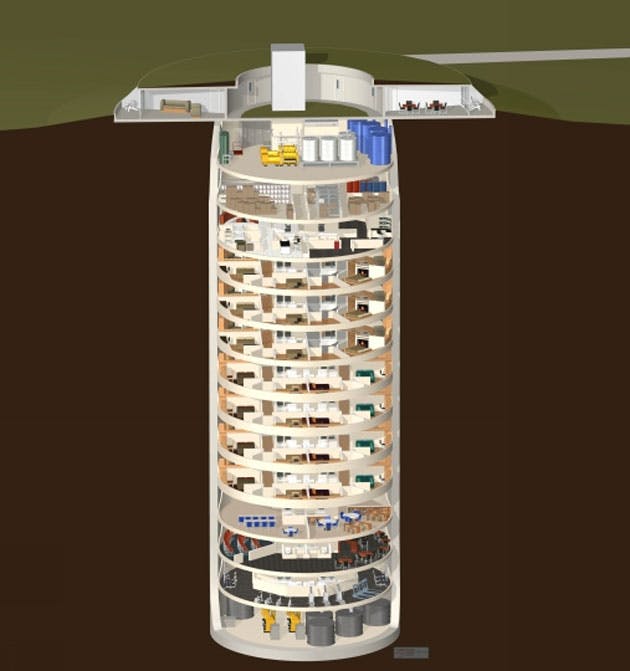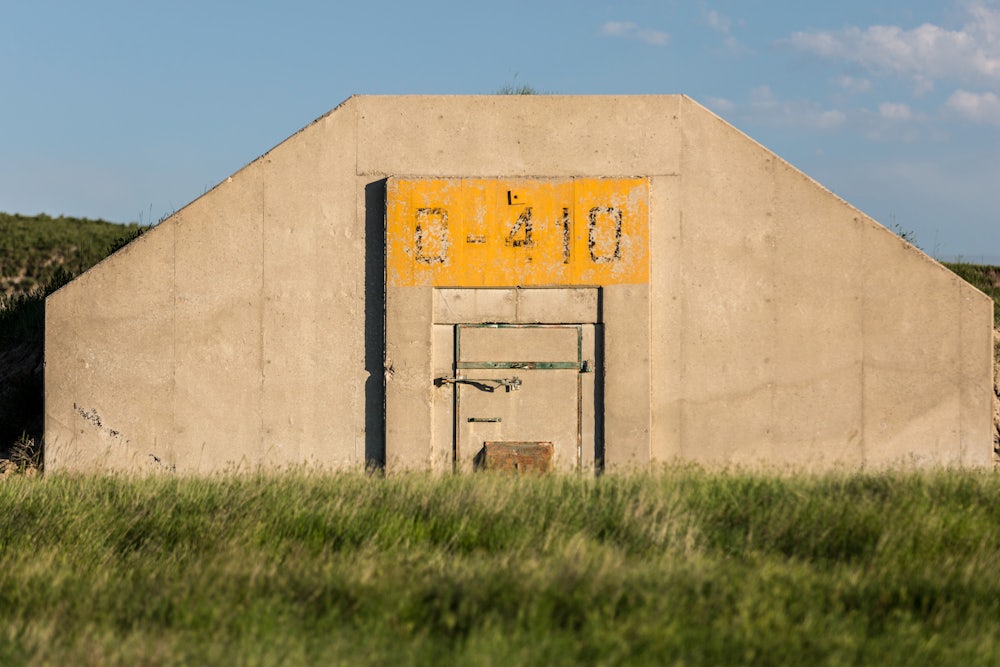A decommissioned nuclear bunker “deep inside a granite mountain” in Switzerland has been put up for sale, according to the Financial Times. Fully hardened against an electromagnetic pulse, the 15,000-square-foot military facility sleeps 1,500 people and features “vehicular tunnels, reservoirs and ‘limitless’ digital bandwidth”—and though the price is secret, the amount is surely obscene. “Your casual nuclear bunker enthusiast,” Judith Evans writes, “need not apply: potential purchasers must demonstrate the capacity to spend £25m before they can receive any further information, including any details of the bunker’s location.” Presumably that knowledge must be closely guarded from the irradiated hordes of our dystopian future.
Such reports have become increasingly common of late: “Armageddon architecture: upmarket bunkers for the worried wealthy.” “Doomsday Prep for the Super-Rich.” “Billionaire Bunkers: How the 1% are Preparing for the Apocalypse.” “Bunker Sales Spike as Some Prepare for Worst Amid Uncertainty.” Flush with cash and nervous about societal instability or even civilizational collapse, the wealthy are increasingly investing in a form of apocalypse insurance: posh shelters where they can ride out the coming calamity, whatever that happens to be. While this trend has obvious appeal, given Americans’ overlapping fascinations with wealth, real estate, and Armageddon, it also illuminates the intersection of two seemingly distinct problems plaguing society: economic inequality and the threat of nuclear war.
Today, nuclear tensions are rising along with profits, but the class responsible for this lucrative rush to war has little reason to fear. It can literally buy its way out of annihilation.
The most famous owner of a bomb shelter today is none other than Donald Trump, whose private club in Florida, Mar-a-Lago, has three of them. They were added by cereal heiress Marjorie Merriweather Post during the Korean War, but Trump decided to use them for storage—and his butler’s office—after purchasing the Palm Beach estate in 1985. Those shelters are relics of the Cold War, but renovated and newly built bunkers have become popular with Trump’s compatriots in the upper crust. Which is only fitting, since he’s partly responsible for the boom: As the Independent reported earlier this year, “Americans [are] building doomsday bunkers in ‘record numbers’ since Donald Trump’s election.”
Back in January, The New Yorker’s Evan Osnos published an extended profile of these new elite preppers:
Survivalism, the practice of preparing for a crackup of civilization, tends to evoke a certain picture: the woodsman in the tinfoil hat, the hysteric with the hoard of beans, the religious doomsayer. But in recent years survivalism has expanded to more affluent quarters, taking root in Silicon Valley and New York City, among technology executives, hedge-fund managers, and others in their economic cohort.
Tellingly, fear of a new October Revolution is driving many of these rich paranoiacs to purchase swank subterranean bunkers or beachfront property in New Zealand. But they’re well prepared for nuclear war, too, and are certainly in a better position to survive than the rest of us in the 99 percent.

Surviving the nukepocalypse in style, while the world burns above, does not come cheap. The Survival Condo Project charges $4.5 million for a two-level penthouse bunker; if you need to economize, there are half-floor units for a reasonable $1.5 million. (The entire compound—a former Atlas missile silo—is currently sold out, but the company is already developing a second location.) CEO Larry Hall claims his compound can support 75 people living entirely off the grid for 5 years—and in theory, could “function indefinitely” through hydroponics and underground fish farming.
But what about jealous outsiders? What if a roving band of mutant proletarians suddenly shows up at the front door? They’re prepared for that, too: The facility has a well-stocked armory, a sniper post, and, per their website, “a military grade security system that includes visible spectrum cameras, infrared cameras, proximity sensors, microphones, trip sensors, passive detectors, as well as confidential defensive systems both automated and manually operated.” If the wretched of the scorched earth miraculously make it through all of that, they will then face walls up to nine feet thick, plus a series of blast doors “designed to withstand sizeable explosives.” Now that’s a gated community.
Hall isn’t the only developer designing ruling class refuges. The Rising S Company of Murchison, Texas, has an entire series of luxury bunkers, the cheapest of which (“The Venetian”) goes more than $3 million and includes a four-car garage, a gym, and a greenhouse; “The Aristocrat,” which costs more than $8 million, features a bowling alley, swimming pool, game room, home theater, sauna, and gun range. There’s also Vivos, whose planned Europa One facility in Germany advertises “life assurance” and accommodations “comparable to a mega-yacht.” In the event of an impending catastrophe, Europa One members will take their private planes to a nearby airport, where they and their staff will be whisked away by helicopter to the underground compound. Vivos promises that once Europa One has been placed in lockdown, its members will be “safely secured from the general public.”
It’s true that life underground after nuclear war would be a step down from the utopian existence currently lived by the super rich. But it would be immeasurably better than the hellscape populated by those left above, who would face radiation sickness, climatic disruption, virulent plagues, mass starvation, and the complete collapse of law and order. There would be no comparison between the catastrophe above and the plush if somewhat claustrophobic life of the wealthy below. The post-apocalyptic divide would be an extreme, almost absurdist example of inequality—a bit like Fiddler’s Green in George Romero’s Land of the Dead—but also a fairly logical extension of the present state of affairs.
Eight men currently own as much wealth as half of all people on Earth. In the United States, economic inequality is currently at levels comparable only to the 1920s. Productivity and compensation have completely diverged, the former continuing to trend steadily upward while the latter has been effectively stagnant for decades. Even the economic gains of the so-called recovery have gone overwhelmingly to the rich—and if Trump and the Republicans get their way with health care and tax reform, things will get even worse.
While working people struggle, the wealthy are pampered by society—materially, legally, even emotionally. As Vox’ Matt Yglesias pointed out recently, these conditions essentially gave us Trump, whose infantile behavior is as much a product of national policy decisions as his own peculiar psychology. To a large extent, the rich have already segregated themselves into a world free from the complications and suffering of everyday life, so perhaps we shouldn’t be surprised when private airport terminals give way to heavily fortified doomsday bunkers.
It has been a longtime trend in arms control and nuclear disarmament discourse to heavily imply that nuclear war will be the “great equalizer,” impacting all of humanity across the board. This claim is usually employed to depoliticize an admittedly controversial issue and make disarmament seem like simple common sense. Nuclear weapons, after all, don’t function like traditional weaponry and are effectively indiscriminate tools of mass slaughter. Since a nuclear explosion would not distinguish between combatants and civilians, doesn’t that imply universal impact? And wouldn’t a nuclear war result in the end of human civilization? Doesn’t everyone, therefore, have a stake in preventing it?
At a purely abstract level, this argument has some validity. Nuclear war would be an unparalleled catastrophe, and it is clearly better for all concerned if the missiles remain in their silos. But neither the rhetorical notion of a “shared stake” nor the arbitrary effects of the bomb equate to universal impact in the real world, which is defined by truly staggering levels of economic inequality. As long as the wealthy possess considerable resources and can invest their surplus wealth in “life assurance,” nuclear war will never impact everyone equally. The inequalities of our world will not vanish after the flash of a nuclear weapon. They will simply become more extreme.
More disturbingly, the narrative of universal impact posits a harmony of interests that may not actually exist. If the wealthy choose to invest in individual survival rather than collective prevention, which side are they on exactly? The thriving market for luxurious mansion-shelters and calamity-proof island real estate comes at the same time the U.S. is embarking on a $1.2 trillion “modernization” of its entire nuclear arsenal. With plutocrats buying up bunkers and defense contractors lining up to produce the next generation of nuclear weapons, it’s difficult not to think of C. Wright Mills’ famous line: “The immediate cause of World War III is the preparation for it.”
We live in very grim times, but if we get out of our silos, as it were, we might even be able to cooperatively push back against the apocalyptic tide. “If I had a billion dollars, I wouldn’t buy a bunker,” Elli Kaplan, a tech CEO, told Osnos of The New Yorker. “I would reinvest in civil society and civil innovation. My view is you figure out even smarter ways to make sure that something terrible doesn’t happen.” Kaplan’s point is couched in the business-friendly language of neoliberal thought leaders, but his basic argument stands. Economic justice—redistribution and reinvestment—would lower the risk of nuclear war because the two issues are inextricably linked. And since “The Aristocrat” is slightly outside my budget, I’d say it’s about time we brought them together.
